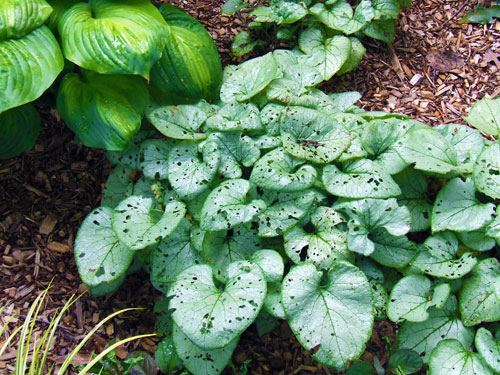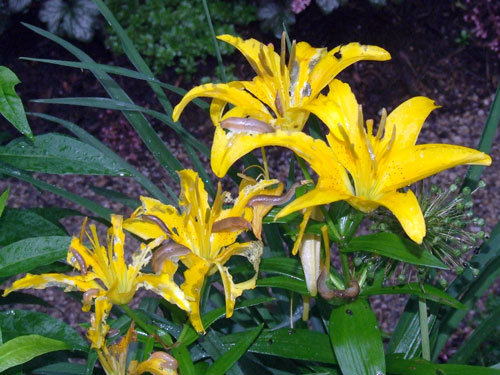Slugs are making tracks on my garden favorites!
Mid-summer slug damage on Hostas and other garden plants sometimes makes the plant look like Swiss cheese.
Early June marks the season for leaves on your favorite garden plants to start looking a bit like Swiss cheese! With spring rains and humid weather, the soft tissue of perennials and annuals are victims of a sneaky garden pest known as the slug.

Hosta, Pulmonaria, Asiatic lily blooms and Brunnera are all favorite perennials of slugs, not to mention many vegetable and herb plants. In most cases, you and I will never see the culprit making all the holes because this shell-less mollusk enjoys doing the tango in your garden during moonlit, dewy nights. If your garden is located near a walk or driveway, clues are left behind by the slug as it slithers across the hard surface in the form of a “trail.”

Management of slugs can be complicated and usually involves a combination of strategies. Hand-picking, trapping with pit fall traps or wet newspapers would be the most environmentally sensitive way to control.
Slugs love to hide at sunup, so nestling a wet, rolled up newspaper at the base of susceptible plants is a great way to “harvest” the mollusks. If you remove and replace the newspapers daily, you will capture dozens of hiding marauders and can fling them into the trash. Gosh that feels good!
Slugs can also be lured into a pit fall trap, but beware – the trap could just become a beer tent for the nightly visits of your slug friends if it is not deep enough. If the trap is something like a soup can or deep saucer, buried deep enough that the lip is just at soil surface, the slugs are attracted to the yeast in the beer and will slither down in for a sip, and hopefully followed by a long nap.
Walking on eggshells
For decades, organic gardeners have been touting the effects of crushed egg shells as a deterrent for slimy slugs. The thought is that the sharp edge on the shells makes it impossible for the soft-bodied creatures to pass over it. Research by Dr. Jeff Gillman at University of Minnesota shows that slugs have no problem traversing across the nasty shells. Even when the shells are pulverized into small pieces, no real deterrent was observed. Conversely, organic gardeners will love hearing that Diatomaceous earth (crushed sediment comprised of abrasive fossils) sold at most garden centers is an excellent molluscicide.
Chemical molluscicides and baits are available, but have varied results and will need to be repeated. Most often the slugs are moving around primarily at night. Keeping a flashlight handy will enable you to find out where they are most concentrated.
Avoid watering late in the day, which creates a perfect environment for them to slide around in the evening. Drip irrigation is probably the best. Several baits are on the markets that are not toxic to dogs or cats. Also, remember that the more you water, the shorter the time the bait will work.
Margaritaville
When I think of slugs, I often think back to that great, Jimmy Buffet song. How does it go? “Waitin’ away in slug-a-ritaville. Poised in the dark with my long shaker of salt.” It has long been known that if you want to get revenge, you wait up until dark and look for the slugs with your flashlight. Simply shake salt on their soft, slimy bodies and voila – they are history. (A little time consuming, I might add.)
For information on earwigs, another serious garden pest, see Earwigs: Bane of summer garden plants.



 Print
Print Email
Email